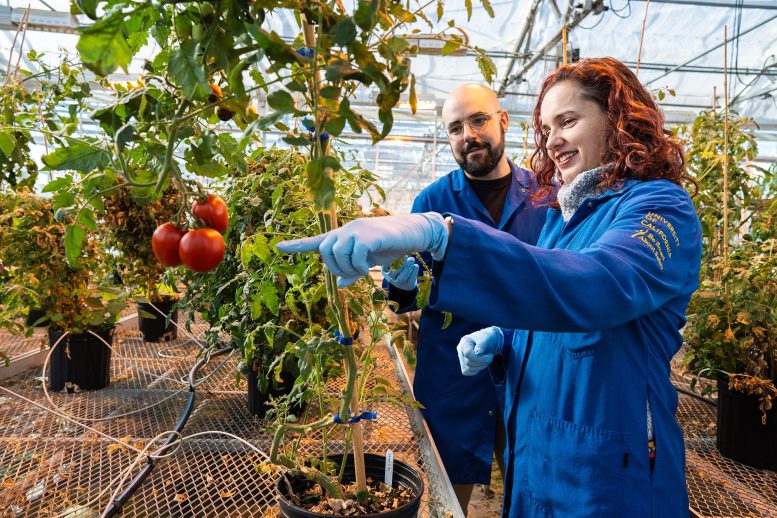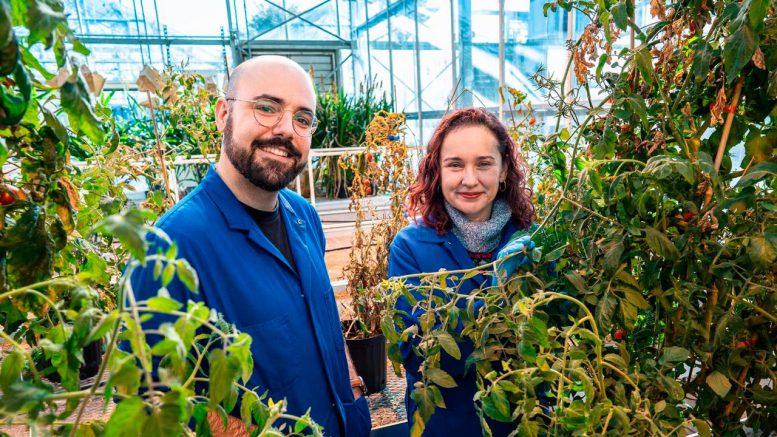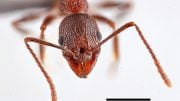
A study by UC Davis uncovered that exodermal suberin in tomato plants is vital for drought resistance. By identifying key genes for suberin production, researchers demonstrated that plants lacking these genes struggle under drought conditions. This finding is a significant step towards creating drought-tolerant crops. Credit: SciTechDaily.com
Research by UC Davis shows that exodermal suberin is crucial for tomato plants’ drought tolerance, paving the way for developing more resilient crops.
Plants have to be flexible to survive environmental changes, and the adaptive methods they deploy must often be as changeable as the shifts in climate and condition to which they adapt. To cope with drought, plant roots produce a water-repellent polymer called suberin that blocks water from flowing up towards the leaves, where it would quickly evaporate. Without suberin, the resulting water loss would be like leaving the tap running.
In some plants, suberin is produced by endodermal cells that line the vessels inside the roots. But in others, like tomatoes, suberin is produced in exodermal cells that sit just below the skin of the root.

New work by Prof. Siobhan Brady and Alex Cantó-Pastor at the UC Davis College of Biological Sciences shows how tomato plants can make themselves more drought-tolerant by producing a waxy substance, suberin, in their roots. Credit: TJ Ushing/UC Davis College of Biological Sciences
Discovering the Role of Exodermal Suberin
The role of exodermal suberin has long been unknown, but a new study by researchers at the University of California, Davis, published on January 2 in Nature Plants shows that it serves the same function as endodermal suberin, and that without it, tomato plants are less able to cope with water stress. This information could help scientists design drought-resistant crops.
“This adds exodermal suberin to our toolbox of ways to help plants survive for longer and cope with drought,” said Siobhan Brady, professor in the UC Davis Department of Plant Biology and Genome Center, and senior author on the paper. “It’s almost like a jigsaw puzzle—if you can figure out which cells have modifications that protect the plant during difficult environmental conditions, you can start to ask questions like, if you build those defenses up one upon the other, does it make the plant stronger?”
In the new study, postdoctoral scholar Alex Cantó-Pastor worked with Brady and an international team of collaborators to uncover the role of exodermal suberin and map the genetic pathways that regulate its production.

New work by Alex Cantó-Pastor (left) and Professor Siobhan Brady, Department of Plant Biology, shows how tomato plants protect themselves from drought by waterproofing their roots. The findings could lead to new ways to breed drought-tolerant tomato and other crops. Credit: TJ Ushing for the College of Biological Sciences
Combining New and Classical Methods
“It’s really the merging of classical and cutting-edge methodology that lets us look at both the process that’s happening in an individual cell and what you see in the whole plant,” said Brady. “So going from super small to really, really big.”
Brady, Cantó-Pastor, and colleagues started by identifying all of the genes that are actively used by root exodermal cells. Then they performed gene editing to create mutant strains of tomato plant that lacked functional versions of several genes they suspected might be involved in suberin production. They discovered seven genes that were necessary for suberin deposition.
Next, the researchers tested exodermal suberin’s role in drought tolerance by exposing some of the mutant tomato plants to a ten-day drought. For these experiments, the researchers focused on two genes: SIASFT, an enzyme involved in suberin production, and SlMYB92, a transcription factor that controls the expression of other genes involved in suberin production.
The experiments confirmed that both genes are necessary for suberin production and that without them, tomato plants are less able to cope with water stress. The mutant plants grew as well as normal plants when they were well-watered but became significantly more wilted after ten days with no water.
Future Prospects and Field Applications
“In both of those cases where you have mutations in those genes, the plants are more stressed and they’re not able to respond to drought conditions,” Brady said.
Having shown suberin’s worth in a greenhouse setting, the researchers now plan to test suberin’s drought-proofing potential in the field.
“We’ve been working on taking this finding and putting it into the field to try and make tomatoes more drought tolerant,” Brady said.
Reference: “A suberized exodermis is required for tomato drought tolerance” by Alex Cantó-Pastor, Kaisa Kajala, Lidor Shaar-Moshe, Concepción Manzano, Prakash Timilsena, Damien De Bellis, Sharon Gray, Julia Holbein, He Yang, Sana Mohammad, Niba Nirmal, Kiran Suresh, Robertas Ursache, G. Alex Mason, Mona Gouran, Donnelly A. West, Alexander T. Borowsky, Kenneth A. Shackel, Neelima Sinha, Julia Bailey-Serres, Niko Geldner, Song Li, Rochus Benni Franke and Siobhan M. Brady, 2 January 2024, Nature Plants.
DOI: 10.1038/s41477-023-01567-x
Additional authors on the paper are: at UC Davis, Lidor Shaar-Moshe, Concepción Manzano, Sharon Gray, He Yang, Sana Mohammad, Niba Nirmal, G. Alex Mason, Mona Gouran, Kaisa Kajala, Kenneth A. Shackel, Donnelly A. West and Neelima Sinha; Prakash Timilsena and Song Li, Virginia Tech; Damien De Bellis, Robertas Ursache and Niko Geldner, University of Lausanne, Switzerland; Julia Holbein, Kiran Suresh and Rochus Benni Franke, Rheinische Friedrich-Wilhelms-University of Bonn, Germany; Alexander T. Borowsky and Julia Bailey-Serres, UC Riverside.,
The work was supported by the National Science Foundation and the Howard Hughes Medical Institute.









Be the first to comment on "Rooted in Survival: Tomato Plants’ Ingenious Drought Defense Uncovered"